The gold of an ancient Indian God
by Luminița Soare
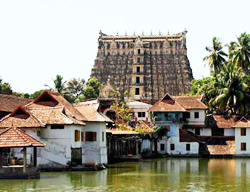 Ancient Indian temples are enveloped in myth and mystery, and some of them hide unimaginable treasures. The astonishment was tremendous, the ruckus caused by the media and the speculations that followed the opening of the underground rooms of the Sri Padmanabhaswami temple were blatantly contrasting the serenity which enveloped this great edifice. Lying across 28 300 m2, with its famous gopuram (tower), a sacred pond and its granite wall, the temple rises up above the crowded horizons of the Thiruvananthapuram (Trivandrum), the capital of Kerala on the South-East coast of Southern India.
Ancient Indian temples are enveloped in myth and mystery, and some of them hide unimaginable treasures. The astonishment was tremendous, the ruckus caused by the media and the speculations that followed the opening of the underground rooms of the Sri Padmanabhaswami temple were blatantly contrasting the serenity which enveloped this great edifice. Lying across 28 300 m2, with its famous gopuram (tower), a sacred pond and its granite wall, the temple rises up above the crowded horizons of the Thiruvananthapuram (Trivandrum), the capital of Kerala on the South-East coast of Southern India.
A detailed official evaluation of the nature and of the cultural value of the treasures found in the underground rooms of the ancient temple will probably ensue, but the collection of at least 20 billion dollars is now considered to be the greatest of its kind. When five of the six underground rooms of the Sri Padmanabhaswami temple were opened on the 30th of June 2011, some extraordinary riches were uncovered, hundreds of kilos of adornments, golden and silver pots, golden coins, diamonds and precious stones, a golden statue of MAHAVISHNU adorned with emeralds and rubies, as well as solid gold representations of Hindu deities. The underground rooms were opened following a directive issued by the Supreme Court of India, while a detailed inventory of the discovered treasures belonging to the temple was done.
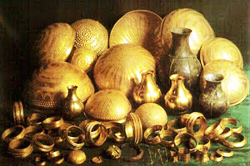 The government of the Kerala state, taken by surprise by the ruckus of this event and alarmed by the security aspects, was forced to mobilize a police cord with multiple rows – including both armed special commandos as well as a 24 hour patrol unit around the temple which used to be supervised by only a few unarmed guards. The chief minister, Oommen Chandy, stated that a series of permanent security measures will be taken but these won’t be an obstacle for the devouts. The decision was made after consulting the Supreme Court of India.
The government of the Kerala state, taken by surprise by the ruckus of this event and alarmed by the security aspects, was forced to mobilize a police cord with multiple rows – including both armed special commandos as well as a 24 hour patrol unit around the temple which used to be supervised by only a few unarmed guards. The chief minister, Oommen Chandy, stated that a series of permanent security measures will be taken but these won’t be an obstacle for the devouts. The decision was made after consulting the Supreme Court of India.
A glimpse of history
The Sri Padmanabhaswami temple is a major symbol for the Hindu culture and has a tremendous religious, archeological and historical value. It is one of the 108 holy halidoms of Visnuism, known as DIVYA DESAMS.
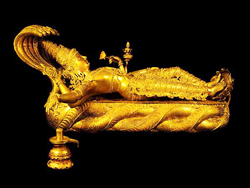 Early history of the temple is lost in the haze of time. There are no trustworthy documents or other sources that would attest when was the original statue of the god VISHNU placed here, in his aspect called ANANTHASAYANAM (in which VISHNU is laying on the snake of the infinite, ANANTA), to which the temple is consecrated to. In some Puranas (Brahma Purana, Matsya Purana, Varaha Purana, Skanda Purana, Padma Purana, Vayu Purana, Bhagavata Purana) there are some references to Sri Padmanathaswami as well as in the Mahabharata.
Early history of the temple is lost in the haze of time. There are no trustworthy documents or other sources that would attest when was the original statue of the god VISHNU placed here, in his aspect called ANANTHASAYANAM (in which VISHNU is laying on the snake of the infinite, ANANTA), to which the temple is consecrated to. In some Puranas (Brahma Purana, Matsya Purana, Varaha Purana, Skanda Purana, Padma Purana, Vayu Purana, Bhagavata Purana) there are some references to Sri Padmanathaswami as well as in the Mahabharata.
Some famous scientists and historians, such as dr. L. A. Ravi Varma of Travancore, have suggested that the temple was built over five thousand years ago, on the very first day of Kali Yuga (the age of maximum spiritual decadence).
A series of legends referring to this temple were passed on over the centuries, uncovering some pieces of information from its history. One of these legends, which can be found both on the old palm leaf inscriptions which can be found in the temple as well as in the famous Ananthasayana Mahatmya writ, states that the halidom was sanctified by a Brahmin Tulu ascetic called Divakara Muni. In the 950th year of Kali Yuga, a reinstallation of the god VISHNU was celebrated in the temple. Some historians and researchers believe that the altar of Thiru Vambadi of Sri Krishnaswami – a separated temple, located within the walls of the main temple – is even older than the Sri Padmanabhaswami temple.
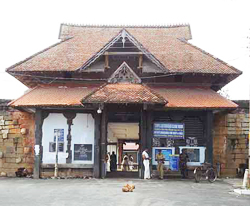 Bhagavata Purana (chant 10, chapter 79) mentions that Sri Balarama visited Syanandorapuram (another name for the Thiruvananthapuram temple) during his pilgrimage, bathed in the Padmathirtham Lake and made some offerings. A similar mention of the Syanandorapuram can be found in the Brahmanda Purana.
Bhagavata Purana (chant 10, chapter 79) mentions that Sri Balarama visited Syanandorapuram (another name for the Thiruvananthapuram temple) during his pilgrimage, bathed in the Padmathirtham Lake and made some offerings. A similar mention of the Syanandorapuram can be found in the Brahmanda Purana.
Such historical references strengthen the belief that this temple is ancient and that throughout the centuries it was considered an important temple of SRI MAHAVISHNU.
The chants dedicated to PADMANABHA (VISHNU from whose belly button the lotus of the universe is sprouting), written by the great Vishnu sage Namalvar, gives proof that this temple existed ever since the 9th century of our era. But, as we’ve shown above, there are many clues indicating that the temple is many centuries older.
Historical evidence are showing the fact that managing the temple used to be the responsibility of a local committee called Ettara Yogam. Ancient manuscripts written on palm leaves show that the foundations of the first temple were built by the leader Kheraman Premual, who was considered to be a sage. He hired several persons in order to help with the multiple tasks involved in the rituals and ceremonies and with the general management of the temple. Around 1050 AD, the temple was rebuilt and the management was re-organized by the leader at that time. The following historical recorded events refer to the times between 1335 and 1384, when Travancore (a previous name for Thiruvanathapuram) was led by a powerful and wise king called Veera Marthanda Varma.
He gradually consolidated his authority over leading and managing the temple. The historical evidence show us that in the year 1375, the Alpasi festival (Alpasi Utsavam, that lasts for ten days, it is one of the two major festivals which are held even to this day) took place within the temple. Between 1459 and 1460, there was a reconstruction of the roof of sanctum sanctorum and the statue of ANANTHASAYANAM was temporarily moved in a balalaya. In 1461, the statue of the god was reinstated to its original location, together with an otakalmandapam (a compact piece of granite stuck on to the sanctum sanctorum). In 1566 the foundation for the gopuram was built. In 1686 a massive fire caused the total destruction of the temple building, the surrounding buildings and the interior installations, with the exception of the main god statue. It was not until 1724 that the temple reconstruction had begun.
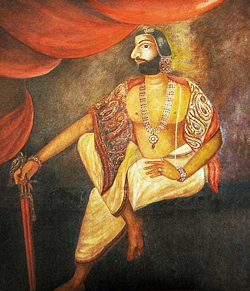 In the year 1728 there were compensating ceremonies held for the fire in 1686. In 1729, the great leader Marthanda Varma became the king of the Travancore and continued the reconstruction of the temple. In 1730, the statue of the god was once again given for keeps in a balalaya, while the sanctum sanctorum was being renovated. It took two more years for this project to be concluded. On this occasion, the old wooden statue of the god ANANTHASAYANAM was replaced with a new one, built out of more than 12.000 salagrama (sacred fossil stones) which were carved by using a special type of mortar called katusarkara yogam.
In the year 1728 there were compensating ceremonies held for the fire in 1686. In 1729, the great leader Marthanda Varma became the king of the Travancore and continued the reconstruction of the temple. In 1730, the statue of the god was once again given for keeps in a balalaya, while the sanctum sanctorum was being renovated. It took two more years for this project to be concluded. On this occasion, the old wooden statue of the god ANANTHASAYANAM was replaced with a new one, built out of more than 12.000 salagrama (sacred fossil stones) which were carved by using a special type of mortar called katusarkara yogam.
This is the main statue that we can see today in the temple, the one in front of which the adoration rituals, puja, are being performed. During the reign of Marthanda Varma, a large part of the temple we can see today was rebuilt. It was in those years that the construction of the gopuram ended, the seven floor pagoda tower which rises above the main East entrance of the temple. Otakal mandapam which lies before the statue of the god was rebuilt, using a single block of granite which was 0.8 meters thick and 6 meters wide.
From the existing historical data, it’s a known fact that 6000 workers and 100 elephants have worked every day for six months in order to conclude the construction of the sribalipura. This great rectangular stone corridor is surrounding the main altars and it’s meant to protect the statues of the deities against the rain when they are being taken out of the temple during different processions. Around the sribalipura, there are 365 stone pillars inlaid with all kinds of representations.
This is the place with access to the underground rooms or kalaras, but devouts do not have access here.
In 1758, during the reign of Sri Karthika Thirunal Rama Varma, the kulasekhara mandapam was built, an exceptional architectural stone work. This is famous for the 28 balustrades made of pillars. The pillars placed in the four corners are said to produce sounds when they are gently tapped.
The opening of the underground chambers
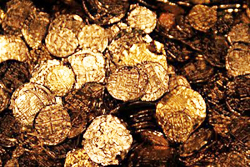 The access with mobile phones, video cameras and electronic equipment is not granted inside the temple. The few people who have managed to take pictures were granted permission to do so only after the intervention of King Uthardom Thirunal Marthanda Varma of Travancore.
The access with mobile phones, video cameras and electronic equipment is not granted inside the temple. The few people who have managed to take pictures were granted permission to do so only after the intervention of King Uthardom Thirunal Marthanda Varma of Travancore.
In 2011, by command of the Supreme Court of India, the committee made of seven members, in the presence of the main procurator of the Travancore trust of the temple of Sri Padmanabhaswami has opened all the underground chambers except the sixth chamber, which is secret. The chambers are placed approximately six meters underground. Extremely valuable gold, diamond and precious stone jewelry have been discovered inside, gold utensils, gold statuettes of gods in the shape of elephants, bags filled with gold coins, including Roman and Napoleonic coins as well as some other treasures, five meter long chainlets adorned with precious stones – the exact length of the god worshipped in the temple.
Thus, ANANTHASAYANAM appears to us as “the richest Hindu god” on Earth, this opulence being the cause of people’s great amazement.
We might say that the time has come for the secret underground chamber B to be opened, the sixth chamber, but the Supreme Court of India has not given the required approval to the committee which is responsible for this, this instance being led by the former judge of the Supreme Court of Kerala, C.S. Rajan.
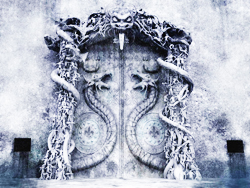 Priests as well as members of the trust and wise astrologers of India consider this underground chamber to be a sacred chamber and thus they believe that it is risky, even dangerous for it to be opened.
Priests as well as members of the trust and wise astrologers of India consider this underground chamber to be a sacred chamber and thus they believe that it is risky, even dangerous for it to be opened.
It is said that the iron door of underground chamber B has no hinges, lock or safety latch. It is believed that it was fixed at the entrance to the secret chamber by operating with certain occult energies, Naga Bandham or Naga Pasam Mantra by siddhas (perfect beings who are endowed with supernatural powers) who lived during the reign of King Marthanda Varma in the sixteenth century.
The door of such a secret chamber can be safely opened only by the sadhus (ascetical mystiques) or mantrikas (yogis who are masters of working with MANTRAS) who are masters of the knowledge of removing Naga Bandham or Naga Pasam by uttering the GARUDA MANTRA. It is believed that currently there is no Siddha Purusha, yogis or mantrikas who are strong enough to know how to correctly operate with the sacred GARUDA MANTRA.
It is also believed that, if someone attempts to open the mysterious underground chamber B through the human technology currently available, there might be some catastrophes occurring inside and around the temple, as well as in the entire India or even in the entire world, according to Vedic Indian astrologers who admitted their own inability to open the door by operating with the secret GARUDA MANTRA.
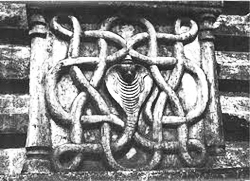 There are many speculations referring to the underground chamber B. For example, the faith that opening it might release certain poisonous chemical substances, that this chamber might lead to a secret place, that an extraordinary treasure guarded by cobras might lie in there, or that other mysterious powers which exist inside might kill those beings who could even try to destroy the door by means of man-made technology. Due to this, the door of the underground chamber B is to this day locked.
There are many speculations referring to the underground chamber B. For example, the faith that opening it might release certain poisonous chemical substances, that this chamber might lead to a secret place, that an extraordinary treasure guarded by cobras might lie in there, or that other mysterious powers which exist inside might kill those beings who could even try to destroy the door by means of man-made technology. Due to this, the door of the underground chamber B is to this day locked.
Another popular belief is that this underground chamber could lead, through a tunnel, to the Indian Ocean, which is close. It is said that this tunnel might have a security or a self-destruction mechanism which would flood the underground chambers, destroy the entire temple and kill anyone inside. All these could happen in the event that the door of the underground chamber be would be opened through man-made technology.
In search of a Vimana aircraft
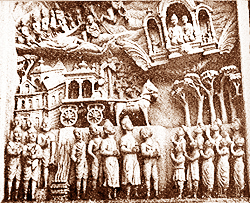 According to the temple authorities, there is a port at the very end of this tunnel. It is said that this port shelters an ancient mysterious flying machine, a so-called Saubha Vimana.
According to the temple authorities, there is a port at the very end of this tunnel. It is said that this port shelters an ancient mysterious flying machine, a so-called Saubha Vimana.
Sanskrit texts are filled with references to gods fighting in the skies by using such Vimana machines which were equipped with weapons whose destructive power was similar to those existing today. For example, there is a passage in the Ramayana that goes like this:
“The Puspaka machine, which resembles the sun himself and who belongs to my brother, was brought by the strong Ravan; this excellent air machinery can go anywhere, at will. It resembles a bright cloud in the sky…”
In the Mahabharata we can read that Asura Maya was in possession of such a Vimana which had at least 5 meters in circumference and it had four strong wheels.
The poem of Mahabharata represents a genuine gold mine when it comes to information regarding the conflicts between gods. During battles, they would apparently make use of some terrible weaponry. Besides their ability of “launching missiles”, the poem speaks of using some other lethal weapons: “the arrow of INDRA” worked through a “circular reflector”. When it was on, it would produce a “beam of light” which would “completely obliterate the target through its tremendous power”.
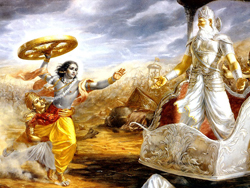 In a certain dialog, the hero KRISHNA follows his enemy SALVA through the air. At some point, the Saubha Vimana of SALVA becomes invisible. Unintimidated by this, KRISHNA immediately makes use of a special weapon: “I have immediately placed an arrow that has killed by detecting sound.”
In a certain dialog, the hero KRISHNA follows his enemy SALVA through the air. At some point, the Saubha Vimana of SALVA becomes invisible. Unintimidated by this, KRISHNA immediately makes use of a special weapon: “I have immediately placed an arrow that has killed by detecting sound.”
Probably the most unsettling and provoking aspect of the ancient texts referring to mythical Vimanas is the fact that they present concrete information which describe the way in which such machines can be built. The instructions are quite accurate also.
In the Sanskrit work of Samarangana Sutradharase, the author says: “The central part of the Vimana should be strong and durable. Just like a great bird which is made of light materials. The mercury engine should be placed inside and underneath it the iron-warming machine should be placed. Through the latent mercury power generating the vortex actuating the apparatus, the one driving the Vimana can travel great distances through air. The motions of the Vimana are the vertical ascending drive, the vertical descending drive, diagonal drive both forward and backward. With the help of these machines, human beings can fly towards the sky and heavenly beings can come to Earth.”
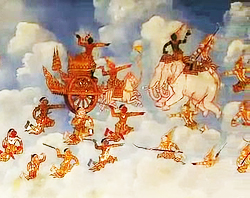 According Bhaktivedanta Swami Prabhupada, ancient Indians revealed the following information regarding the Saubha Vimana: “The flying machine SALVA used was very mysterious. It was so amazing that when it appeared in the air, you would sometimes think that there are many aircrafts in the sky, and other times it seemed that there isn’t any. Sometimes the aircraft was visible, sometimes it was not. The warriors of the Yadu dynasty were puzzled, they couldn’t tell exactly what the location of this unusual flying machine was. Sometimes they would see the machine on the ground, sometimes they would see it flying in the air, sometimes they would see it on top of a hill and sometimes they would see it floating on water. The extraordinary aircraft flew in the sky like a swirling flame – it never stood still, not for one moment.”
According Bhaktivedanta Swami Prabhupada, ancient Indians revealed the following information regarding the Saubha Vimana: “The flying machine SALVA used was very mysterious. It was so amazing that when it appeared in the air, you would sometimes think that there are many aircrafts in the sky, and other times it seemed that there isn’t any. Sometimes the aircraft was visible, sometimes it was not. The warriors of the Yadu dynasty were puzzled, they couldn’t tell exactly what the location of this unusual flying machine was. Sometimes they would see the machine on the ground, sometimes they would see it flying in the air, sometimes they would see it on top of a hill and sometimes they would see it floating on water. The extraordinary aircraft flew in the sky like a swirling flame – it never stood still, not for one moment.”
Some say that it is possible that such a mysterious Saubha Vimana to be awaiting for its discovery in the underground world of Trivandrum, in the state of Kerala, in the South of India. As a matter of fact, there was such news going around this year in February, but it turned out the news was false.
yogaesoteric
march 2015
Also available in:
 Română
Română
